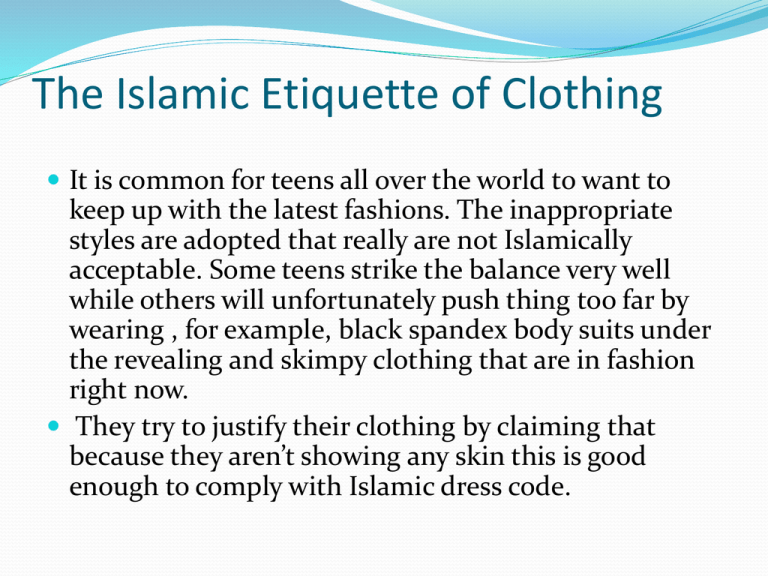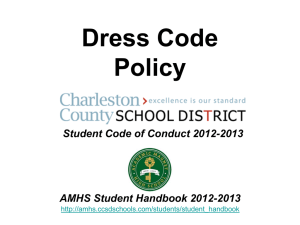
The Islamic Etiquette of Clothing
It is common for teens all over the world to want to
keep up with the latest fashions. The inappropriate
styles are adopted that really are not Islamically
acceptable. Some teens strike the balance very well
while others will unfortunately push thing too far by
wearing , for example, black spandex body suits under
the revealing and skimpy clothing that are in fashion
right now.
They try to justify their clothing by claiming that
because they aren’t showing any skin this is good
enough to comply with Islamic dress code.
Deep in their hearts they probably know that what
they are wearing is not good. The fact is that they have
become “fashion victims” which severely impairs their
sense of reasons.
There is a common misconception that to dress
Islamically, women have to wear black robes with no
style, and men are to wear white.
In this chapter, we will consider what the requirements
of Islamic dress are. First, let’s learn what the Qur’an
says about clothing:
Clothes in the Qur’an
َ
اري َس ْوآ ِت ُك ْم َو ِري ً
شا ۖ َولِ َباسُ
َيا َب ِني آدَ َم َق ْد أ ْن َز ْل َنا َعلَ ْي ُك ْم لِ َباسًا ي َُو ِ
ُون
ال َّت ْق َو ٰى ٰ َذلِ َك َخ ْي ٌر ۚ ٰ َذلِ َك ِمنْ آ َيا ِ
َّللا لَ َعلَّ ُُ ْم َي َّذ َّكر َ
ت َّ ِ
O Children of Adam! We have bestowed
raiment upts) and as an adornment, and the
raiment of righteousness, that is better.
Such are among the Ayât (proofs, evidences,
verses, lessons, signs, revelations, etc.) of
Allâh, that they may remember (i.e. leave
falsehood and follow truth).
َ َي ْن ِز ُع َع ْن ُُ َما َيا َب ِني آدَ َم ََل َي ْف ِت َن َّن ُك ُم ال َّشي
ْطانُ َك َما أَ ْخ َر َج أَ َب َو ْي ُك ْم ِم َن ْال َج َّن ِة
ُ ِمنْ َحي
اس ُُ َما لِي ُِر َي ُُ َما َس ْوآ ِت ُِ َما ۗ إِ َّن ُه َي َرا ُك ْم ُه َو َو َق ِبيلُ ُه
َ ْث ََل َت َر ْو َن ُُ ْم ۗ إِ َّنا لِ َب
ين ََل
ِ ون َج َع ْل َنا ال َّش َي
َ ين أَ ْولِ َيا َء لِلَّ ِذ
َ اط
َ ي ُْؤ ِم ُن
O Children of Adam! Let not Shaitân
(Satan) deceive you, as he got your parents
[Adam and Hawwa (Eve)] out of Paradise,
stripping them of their raiments, to show
them their private parts. Verily, he and
Qabîluhu (his soldiers from the jinn or his
tribe) see you from where you cannot see
them. Verily, We made the Shayâtin (devils)
Auliyâ' (protectors and helpers) for those
Du’aa
الحمد هلل الذي رزقني من الرياش ما أتجمل به في الناس و أواري به
عورتى
“Praise be to Allah who granted me the clothes that made
me look good in front of people and cover my body.
Clothing
Table: ‘Awrah For Males
And Females
In Public
With Same Sex
Relatives
With Opposite
Sex Relatives
Emergency and
Extreme
Situations5
Man
Navel to knees
Navel to knees
Mahram1:
Navel to knees
Non-Mahram2
Neck to Knees
Open,
As necessary
Woman
Head to toe
Except hands
And face
Neck to Knees
Mahram 3:
Neck to knees
Non-Mahram4:
Head to toe
Except hands
And face.*
Open,
As necessary
1. Mother, grandmother, daughter, grand
2.
3.
4.
5.
daughter, sister, niece and aunt.
Cousin and sister in law.
Father, grandfather, son, grand son,
brothers, nephew and uncle.
Cousin and brother in law.
Surgery, rescue, doctor visits (When
same sex doctor is not available).
5. Mother, Grandmother, daughter, grand daughter,
sister, niece and aunt.
6. Cousin and sister in law.
7. Father, grandfather, son, grandson, brothers, nephew
and uncle.
8. Cousin and brother in law.
* Some scholars say that women must also cover their
face and hands. This contradicts many authentic
ahadeeth that allow women to show the face and
hands, without make up, of course. The feet must
also be covered according to the majority of scholars.
Imaam at-Tirmidhi and Abu Dawud reported that
Prophet Muhammed (PBUH.) ordered Ummuh
Salmah And Aysha to cover their feet during Salah
and in public.
Hadeeth Shareef
قال رسول َّللا صلي َّللا عليه وسلم:عن عبدَّللا بن جعفر رضي َّللا عنه قال
.“”ما بين السرة ألي الركبة عورة
Abdullah Ibn Jaf’far once said to a group of men, “The
Prophet said: ‘Between the Navel and the knee is
“Awrah”(for males).”
Showing Off!
It is common among teens and adults to show off in
front of their peers when they wear “cool” clothes.
Muslims must not boast and brag about their outfits.
It is Haraam in Islam to feel and show arrogance in
any way, including through the clothing one wears. In
the past, some people would wear clothing with
pride and arrogance. Prophet Muhammed prohibited
acting in a boastful manner by donning clothing that
indicated wealth and status.
For example, some men would wear robes with
trains that dragged along the ground as they
walked to show off their status. They tried their
best to look special and attract other’s attention.
They didn’t care about the feelings and emotions
of humble and poor people around them who were
less fortunate.
In fact, many people used to have garments that
barely covered the knees or a little lower.
Therefore, the Prophet prohibited Muslims from
wearing long clothes lower than ankles as a way to
show their pride.
Islamic Standards Of Clothing
When we consider evaluating fashion, we must first refer to
the basic Islamic principles of modest clothing:
1. Men and women are allowed and even encouraged to
wear neat, clean clothing in public. A man once asked
Prophet Muhammed if wearing neat clothes and shoes
can be Haram. He answered: “Allah is beautiful and
loves beauty.”
2. Men and women should refrain from wearing any type
of clothing that is provocative and may attract the
forbidden looks of others. Allah says in Surat-un-Noor,
ۖ َُّوب ُِن
َ َو ََل ُي ْب ِد
ِ ين ِزي َن َتُُنَّ إِ ََّل َما َظ َُ َر ِم ْن َُا ۖ َو ْل َيضْ ِرب َْن ِب ُخم ُِرهِنَّ َعلَ ٰى ُجي
“And they should not display their beauty except what
appears thereof [rings,bracelets] and let them cover
their bosoms with parts of khimars [scarves]”
3. Men should cover most of their bodies from the neck
down. However in certain situations, like during sports
and physical labor, they must at least cover the area
from the waist or the navel to the knees in front of men
or women. It is also encouraged to wear a shirt around
women so that one is not showing off the physique to
the opposite sex
4. Women must cover everything except for the face and hands
in public. When they are in private or just around women,
they can uncover their hair, arms, legs to the knees and wear
relaxed clothing. Allah says in Surat-ul-Ahzab:
ين َعلَي ُِْنَّ ِمنْ َج ََل ِب ِيب ُِنَّ ۚ ٰ َذلِ َك
َ ين ي ُْد ِن
َ َيا أَ ُّي َُا ال َّن ِبيُّ قُ ْل ِِلَ ْز َوا ِج َك َو َب َنا ِت َك َو ِن َسا ِء ْالم ُْؤ ِم ِن
َّ ان
َّللاُ َغفُورً ا َر ِحيمًا
َ أَ ْد َن ٰى أَنْ يُعْ َر ْف َن َف ََل ي ُْؤ َذي َْن ۗ َو َك
O Prophet! Tell your wives and your daughters and the women
of the believers to draw their cloaks (veils) all over their
bodies (i.e.screen themselves completely except the eyes or
one eye to see the way). That will be better, that they should
be known (as free respectable women) so as not to be
annoyed. And Allah is Ever Oft¬Forgiving, Most Merciful
5. Covered areas must not be visible through
transparent fabric nor can one’s physical shape can be
observed through tight clothing
6. Men should not wear clothing that is directly or
commonly associated with women, and women should
not wear clothing that is directly and commonly
associated with men.
Prophet Muhammed said, "Allah curses men who
imitate women, and women who imitate men,”
Haram and Halal
Haram for Men
There are certain clothes, jewelry, and fashions that are
haram for men to wear.They include the following:
1. Gold Jewelry and silk-Based Clothes.
Any clothes made of silk are prohibited for men in Islam.
Prophet Muhammad wore silk a few times, then Allah
made it Haram for males. Prophet Muhammad once
carried gold jewelry and silk clothes and said, “These are
unlawful for men among my people In another Hadeeth,
the Prophet said, “Whoever wears silk in this life will not
wear it in the next life(in Jannah.”
As for gold, Imam Muslim reported that Ali Ibn Abi Talib
once said:
نُاني رسول َّللا صلى َّللا عليه و سلم عن التختم بالذهب
Rasoolullah prohibited me from wearing gold rings.”
2. Imitating women:
Sometimes we see men wearing women’s clothing, jewelry
and even make-up. They adopt feminine hairstyles and
fashion. Don’t you think they look strange and unnatural?
Prophet Muhammad prohibited men from dressing l-Band
behaving like women and vice versa. Imam Al-Bukhari
reported that Ibn Abbas once said:
لعن رسول َّللا صلى َّللا عليه وسلم الرجال المتشبُين بالنساء والنساء المتشبُات
. بالرجال
“Rasoolullah cursed men who imitate women and cursed
women who imitate men as well.”
3. Revealing clothes.
Any clothes that reveal men’s ‘awraw’ or private
parts are Haram to wear. According to most
scholars and imams, a muslim male must cover
the area from the navel to the knees. In the
Maliki School of fiqh, the awrah of a male
muslim is what is usually covered with one’s
underwear. This is due to reports that there
were occasions when the prophet was seen with
part of his thighs exposed. However, there are
many authentic ahadeeth that prohibit
showing one’s thighs, for example
Imam Ahmad, At-tirmithi and Abu Dawood reported that
Rasoolullah was in the masjid and saw a Sahabi called
Jurhud who was lying down and showing part of his thigh.
The Prophet then ordered Jurhud to cover his thigh and
said to his thigh and said to him:
الفخذ عورة
The thigh is ‘awrah’
Haram for Women
1. Revealing and Tight Clothing.
Any clothing that reveals the woman’s awrah is obviously
haram to wear.
According to most scholar and imams, a Muslim female
must cover all her body except her face and hands. Once
Asmaa,bint Abi Bakr, Aisha,s sister, came to visit her sister.
She wore some see-through and tight clothes. When Prophet
Muhammad saw her he didn’t like the she dressed. So he
said: “ O Asmaa’ When reaches the age of puberty she must
properly cover all of her body except her face and hands.”
The above Hadeeth and other confirm that uncovering the
‘awrah is prohibited. Revealing the ‘awrah by wearing tight
or see through clothes is forbidden as well.
Wearing tight shirts, pants, dresses or skirts that cover the
skin, but shape the body’s figure make girls look attractive
for males. Some girls even wears tight shirts or outfits that
have wording or designs on the chest or other attractive
parts of their bodies. This behavior obviously attracts men’s
attention and would lead to temptation. This behavior is
prohibited in Islam according to all schools of fiqh.
2. Makeup and perfume
Wearing makeup and putting glittery lip gloss on is
forbidden because it would be attracting boys to focus
on the girl’s facial features. Putting on perfume that
could attract the attention of men is prohibited.
Some girls wear proper dress code but they also wear
make up. This defeats the very purpose of hijab,
because cosmetics obviously make girls look even
more attractive.
Allah says in Surat-un-Noor:
ُوجُُنَّ
َوقُ ْل لِ ْلم ُْؤ ِم َنا ِ
ارهِنَّ َو َيحْ َف ْظ َن فُر َ
ت َي ْغضُضْ َن ِمنْ أَب َ
ْص ِ
ُوب ُِنَّ ۖ َو ََل
َو ََل ُي ْب ِد َ
ين ِزي َن َتُُنَّ إِ ََّل َما َظ َُ َر ِم ْن َُا ۖ َو ْل َيضْ ِرب َْن ِب ُخم ُِرهِنَّ َعلَ ٰى ُجي ِ
ين ِزي َن َتُُنَّ إِ ََّل لِ ُبعُولَ ِت ُِنَّ أَ ْو آ َبا ِئ ُِنَّ أَ ْو آ َبا ِء ُبعُولَ ِت ُِنَّ أَ ْو أَ ْب َنا ِئ ُِنَّ أَ ْو أَ ْب َنا ِء
ُي ْب ِد َ
ُبعُولَ ِت ُِنَّ أَ ْو إِ ْخ َوا ِن ُِنَّ أَ ْو َب ِني إِ ْخ َوا ِن ُِنَّ أَ ْو َب ِني أَ َخ َوا ِت ُِنَّ أَ ْو ِن َسا ِئ ُِنَّ أَ ْو َما َملَ َك ْ
ت
ال أَ ِو ِّ
ين لَ ْم َي ْظ َُرُوا
أَ ْي َما ُنُُنَّ أَ ِو ال َّت ِاب ِع َ
الط ْف ِل الَّ ِذ َ
ين َغي ِْر أُولِي ْاْلِرْ َب ِة ِم َن الرِّ َج ِ
ين ِمنْ ِزي َن ِت ُِنَّ ۚ
َعلَ ٰى َع ْو َرا ِ
ت ال ِّن َسا ِء ۖ َو ََل َيضْ ِرب َْن ِبأَرْ ُجلِ ُِنَّ لِيُعْ لَ َم َما ي ُْخفِ َ
ُون
َوقُ ْل
ون لَ َعلَّ ُك ْم ُت ْفلِح َ
َّللا َج ِميعًا أَ ُّي َه ْالم ُْؤ ِم ُن َ
َ 31.و ُتوبُوا إِلَى َّ ِ
ين ِزي َن َتُُنَّ إِ ََّل
لِ ْلم ُْؤ ِم َنا ِ
ُوجُُنَّ َو ََل ُي ْب ِد َ
ارهِنَّ َو َيحْ َف ْظ َن فُر َ
ت َي ْغضُضْ َن ِمنْ أَب َ
ْص ِ
ين ِزي َن َتُُنَّ إِ ََّل
ُوب ُِنَّ ۖ َو ََل ُي ْب ِد َ
َما َظ َُ َر ِم ْن َُا ۖ َو ْل َيضْ ِرب َْن ِب ُخم ُِرهِنَّ َعلَ ٰى ُجي ِ
لِ ُبعُولَ ِت ُِنَّ أَ ْو آ َبا ِئ ُِنَّ أَ ْو آ َبا ِء ُبعُولَ ِت ُِنَّ أَ ْو أَ ْب َنا ِئ ُِنَّ أَ ْو أَ ْب َنا ِء ُبعُولَ ِت ُِنَّ أَ ْو إِ ْخ َوا ِن ُِنَّ
أَ ْو َب ِني إِ ْخ َوا ِن ُِنَّ أَ ْو َب ِني أَ َخ َوا ِت ُِنَّ أَ ْو ِن َسا ِئ ُِنَّ أَ ْو َما َملَ َك ْ
ين
ت أَ ْي َما ُنُُنَّ أَ ِو ال َّت ِاب ِع َ
ال أَ ِو ِّ
ت
ين لَ ْم َي ْظ َُرُوا َعلَ ٰى َع ْو َرا ِ
الط ْف ِل الَّ ِذ َ
َغي ِْر أُولِي ْاْلِرْ َب ِة ِم َن الرِّ َج ِ
َّللا
ين ِمنْ ِزي َن ِت ُِنَّ ۚ َو ُتوبُوا إِلَى َّ ِ
ال ِّن َسا ِء ۖ َو ََل َيضْ ِرب َْن ِبأَرْ ُجلِ ُِنَّ لِيُعْ لَ َم َما ي ُْخ ِف َ
ُون
ون لَ َعلَّ ُك ْم ُت ْفلِح َ
َج ِميعًا أَ ُّي َه ْالم ُْؤ ِم ُن َ
31.
And tell the believing women to lower their gaze (from
looking at forbidden things), and protect their private parts
(from illegal sexual acts) and not to show off their
adornment except only that which is apparent (like both
eyes for necessity to see the way or outer dress like veil,
gloves, head-cover, apron, etc.), and to draw their veils all
over Juyubihinna (i.e. their bodies, faces, necks and
bosoms,) and not to reveal their adornment except to their
husbands, or their fathers, or their husband's fathers, or
their sons, or their husband's sons, or their brothers or
their brother's sons, or their sister's sons, or their (Muslim)
women (i.e. their sisters in Islâm), or the (female) slaves
whom their right hands possess, or old male servants who
lack vigour, or small children who have no sense of the
feminine sex. And let them not stamp their feet so as to
reveal what they hide of their adornment. And all of you
beg Allâh to forgive you all, O believers, that you may be
successful
And tell the believing women to lower their gaze (from looking at forbidden things), and protect their private parts (from illegal sexual acts) a
Girls must also avoid plucking their eye brows like many do
in current days.
Abdullah ibn Abbas narrated that Prophet Muhammad
cursed the woman who plucks her eye brows and the one
who does foe her.
Activity 1:
Consider the following for girls. Are they forbidden,
discouraged or permissible?
1.
Text written on the back your pants.
2. Flashy colored scarf.
3. Text written on the front of your shirt.
4. Shoes that make a clicking noise when you walk.
5. Wearing pants instead of a skirt especially pants that
are so tight and shape your figure.
6. Wearing a loose sweat shirt and rolling up the
sleeves.
7- Letting hair fall out from the front and/ or the back
of a scarf.
8- Wearing a loose shirt that just covers the buttocks
and tight pants.
9- A low cut neckline that your scarf does not cover.
Activity 2.
Consider the following for boys. Are they
forbidden, discouraged or permissible?
1. Wearing shorts that go above the knee.
2. Changing in front of your friends.
3. Changing in front of your brother.
4. Playing sports without a shirt on in front of girls.
5. Text written on the back of your pants.
6- Wearing a tight shirt in front of girls.
7- Looking at girl’s fashion magazines.
8- Wearing perfume in public.
9- Text written on the back of your pants.
Activity 3.
Research the following issues using website like
www.Islamonline.net, www. Islamicicity.com, and
others to learn what the Islamic stance on them:
1. Body piercing
2. Tattooing
3. Plucking eyebrows
4. Nail polish
Study Questions
1.
2.
3.
4.
5.
What does Allah mean by “But the garment of piety
is the best.”ولباس التقوى ذلك خير
Compare and contrast the ‘Awrah for men and
women in Islam.
What is the purpose of clothing in Islam? Support
your answer with an Ayah.
What is the du ‘aa’ the Prophet used to say when he
put on his clothes?
What are the standards of acceptable fashion in
Islam?
What parts should men and women properly cover
with clothing?
7. What is the hukm, or ruling, concerning hijab for
Mulim women? Support your answer with ayaat and a
hadeeth.
8. Describe three prohibited styles of clothing for men.
9. Describe three prohibited styles of clothing for
women.
10. Write Du ‘aa’ for wearing new clothe without looking
in the book.
11. Memorize and write Hadeeth Shareef about “Awrah”
6.






